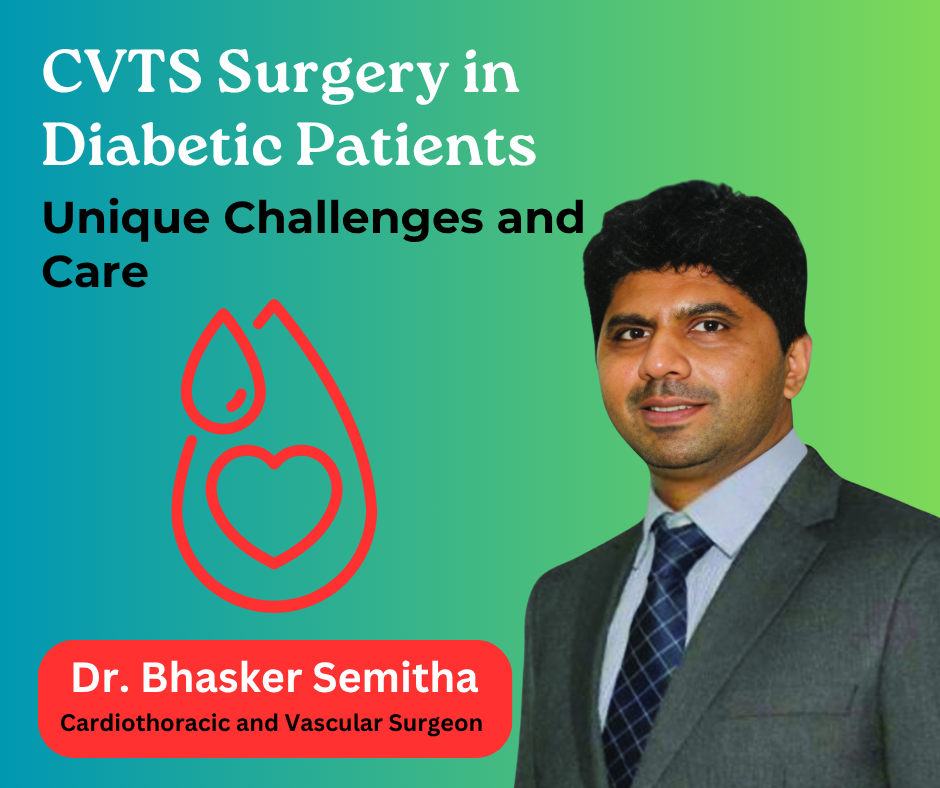Introduction
Cardiovascular and thoracic surgeries (CVTS) are complex procedures that demand meticulous planning and precision. When the patient is diabetic, the challenges increase significantly. As a Cardiothoracic and Vascular Surgeon, I frequently encounter such high-risk cases and it is essential to educate patients and caregivers about what makes heart and vascular surgery in diabetic individuals more delicate—and how we navigate these complexities successfully.
Why Diabetes Matters in CVTS Surgery
Diabetes is not just a blood sugar problem—it is a systemic disease that affects nearly every organ system. For CVTS patients, diabetes increases the risk of:
- Coronary artery disease (CAD): Diabetics often have more diffuse and calcified blockages.
- Poor wound healing: High glucose levels impair the immune system and delay recovery.
- Increased infection rates: Especially at the surgical site or in the chest (sternal wound infections).
- Kidney dysfunction: Which complicates post-operative fluid and medication management.
- Peripheral vascular disease: Making vascular access and grafting more challenging.
Preoperative Assessment – The First Crucial Step
We follow a rigorous pre-surgery protocol for diabetic patients:
- Comprehensive cardiac evaluation including echocardiogram, angiography, and stress testing.
- Glycemic control optimization in coordination with endocrinologists.
- Screening for diabetic complications like nephropathy, retinopathy, and neuropathy.
- Nutritional assessment and blood sugar monitoring over time, not just on the day of surgery.
Intraoperative Considerations
During surgery, the diabetic body responds differently. Some of the special strategies we adopt include:
- Maintaining tight intraoperative glucose control with insulin infusions.
- Use of arterial grafts (like the internal mammary artery) which offer better long-term outcomes in diabetics compared to saphenous vein grafts.
- Extra care to avoid excessive blood loss and maintain stable hemodynamics.
- Strict aseptic techniques to minimize infection risk.
Postoperative Care – A Delicate Balance
Recovery after CVTS in diabetic patients needs intensive monitoring, including:
- Frequent blood glucose checks and insulin adjustments.
- Monitoring for wound infection, especially around the sternum.
- Supporting the kidneys and electrolytes, which may be sensitive to medications.
- Early mobilization, physiotherapy, and nutritional guidance for better healing.
- Education on long-term care and lifestyle modification to avoid recurrence.
Final Thoughts
While diabetes increases the complexity of CVTS surgery, it does not mean surgery is unsafe or impossible. With the right surgical team, careful planning, and a patient-centered approach, outcomes can be excellent—even in high-risk diabetic patients.
At Hridaya Navjeevanalaya Clinic, we are committed to offering advanced cardiac and thoracic care with empathy, precision, and excellence. If you or a loved one has diabetes and heart disease, consult a specialized CVTS surgeon before it’s too late.
About Dr. Bhasker Semitha
Dr. Bhasker Semitha is a highly skilled and experienced Cardiothoracic and Vascular Surgeon, specializing in coronary artery bypass surgery, valve repair and replacement, vascular procedures, and minimally invasive thoracic surgery. With a compassionate approach and advanced techniques, he has helped transform the lives of hundreds of heart patients across Navi Mumbai.
📍 Hridaya Navjeevanalaya Clinic, Navi Mumbai
📞 8655073438


……